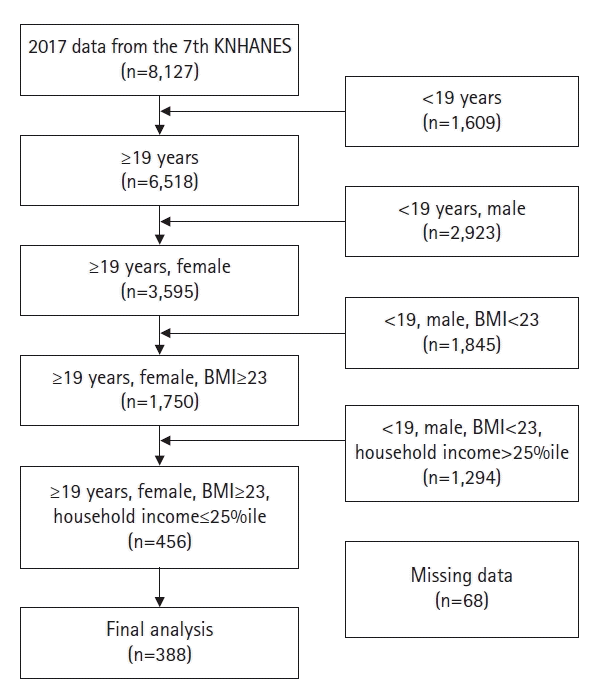1. Korea Disease Control and Prevention Agency. Korea Health Statistics 2019: Korea National Health and Nutrition Examination Survey (KNHANES Ⅷ-1) [Internet]. Cheongju: Author; 2020 [cited 2021 Jan 16]. Available from:
https://knhanes.cdc.go.kr/knhanes/sub04/sub04_03.do.
5. Pureza IR, Melo IS, Macena ML, Praxedes DR, Vasconcelos LG, Silva-Júnior AE, et al. Acute effects of time-restricted feeding in low-income women with obesity placed on hypoenergetic diets: randomized trial. Nutrition. 2020; 77:110796.
https://doi.org/10.1016/j.nut.2020.110796.

6. An SJ, Park EJ, Cheon JH, Hwang HJ, Kim MJ. Prospective study for evaluating therapeutic efficacy of obese patients of low socioeconomic status in Korea. Korean J Health Promot. 2017; 17(2):54–63.
https://doi.org/10.15384/kjhp.2017.17.2.54.

7. Lee HM, Jung HJ, Jung IK. Relationships among metabolically healthy status, physical activity, and sedentary behavior according to obesity in low-income menopause women. Asian J Physical Educ Sport Sci. 2020; 8(2):75–89.
https://doi.org/10.16915/jkapesgw.2018.06.32.2.131.

8. Donabedian A. Aspects of medical care administration: specifying requirements for health care. Cambridge: Harvard University Press;1973. p. 65–68.
9. Diamant AL, Hays RD, Morales LS, Ford W, Calmes D, Asch S, et al. Delays and unmet need for health care among adult primary care patients in a restructured urban public health system. Am J Public Health. 2004; 94(5):783–789.
https://doi.org/10.2105/ajph.94.5.783.

10. Kim TH. The challenges of social welfare education in the health and medical service sector: focusing on relationship between unmet health services needs and social isolation. Korean J Soc Welf Educ. 2014; 25:123–146.
12. Heo J, Oh J, Kim J, Lee M, Lee JS, Kwon S, et al. Poverty in the midst of plenty: unmet needs and distribution of health care resources in South Korea. PLoS One. 2012; 7(11):e51004.
https://doi.org/10.1371/journal.pone.0051004.

13. Chae HJ, Kim M. Unmet healthcare needs and related factors according to gender differences in single-person household. Korean J Women Health Nurs. 2020; 26(1):93–103.
https://doi.org/10.4069/kjwhn.2020.03.23.

14. Reeves A, McKee M, Mackenbach J, Whitehead M, Stuckler D. Public pensions and unmet medical need among older people: cross-national analysis of 16 European countries, 2004-2010. J Epidemiol Community Health. 2017; 71(2):174–180.
https://doi.org/10.1136/jech-2015-206257.

15. Karanikolos M, Gordeev VS, Mackenbach JP, McKee M. Access to care in the Baltic States: did crisis have an impact? Eur J Public Health. 2016; 26(2):236–241.
https://doi.org/10.1093/eurpub/ckv205.

16. Kim Y, Kim S, Jeong S, Cho SG, Hwang SS. Poor people and poor health: examining the mediating effect of unmet healthcare needs in Korea. J Prev Med Public Health. 2019; 52(1):51–59.
https://doi.org/10.3961/jpmph.18.162.

19. Andersen RM. Revisiting the behavioral model and access to medical care: does it matter? J Health Soc Behav. 1995; 36(1):1–10.

21. Regional Office for the Western Pacific, World Health Organization. The Asia-Pacific perspective: redefining obesity and its treatment. Sydney: Health Communications Australia;2000.
23. Gelberg L, Andersen RM, Leake BD. The behavioral model for vulnerable populations: application to medical care use and outcomes for homeless people. Health Serv Res. 2000; 34(6):1273–1302.
25. Nho JH, Hwang ES. Effects of multidisciplinary lifestyle modification program on health-promoting behavior, psychological distress, body composition and reproductive symptoms among overweight and obese middle-aged women. Korean J Adult Nurs. 2019; 31(6):663–676.
https://doi.org/10.7475/kjan.2019.31.6.663.

26. Kim SR, Nho JH, Kim JY, Hur J. Effects of a lifestyle intervention based on type D personality in overweight and obese middle-aged women: a feasibility study. Worldviews Evid Based Nurs. 2020; 17(5):393–403.
https://doi.org/10.1111/wvn.12457.

27. Jeon JA. Korean Women’s mental health indicators. Health Welf Forum. 2016; 5:47–60.
29. Thammatacharee N, Tisayaticom K, Suphanchaimat R, Limwattananon S, Putthasri W, Netsaengtip R, et al. Prevalence and profiles of unmet healthcare need in Thailand. BMC Public Health. 2012; 12:923.
https://doi.org/10.1186/1471-2458-12-923.

33. Stein J, Liegert P, Dorow M, König HH, Riedel-Heller SG. Unmet health care needs in old age and their association with depression - results of a population-representative survey. J Affect Disord. 2019; 245:998–1006.
https://doi.org/10.1016/j.jad.2018.11.096.

35. Gonda X, Pompili M, Serafini G, Carvalho AF, Rihmer Z, Dome P. The role of cognitive dysfunction in the symptoms and remission from depression. Ann Gen Psychiatry. 2015; 14:27.
https://doi.org/10.1186/s12991-015-0068-9.

36. Lam RW, Kennedy SH, Mclntyre RS, Khullar A. Cognitive dysfunction in major depressive disorder: effects on psychosocial functioning and implications for treatment. Can J Psychiatry. 2014; 59(12):649–654.
https://doi.org/10.1177/070674371405901206.

37. Cummings SM, Cassie KM. Perceptions of biopsychosocial services needs among older adults with severe mental illness: met and unmet needs. Health Soc Work. 2008; 33(2):133–143.
https://doi.org/10.1093/hsw/33.2.133.

39. Papageorgiou K, Vermeulen KM, Schroevers MJ, Stiggelbout AM, Buskens E, Krabbe PF, et al. Do individuals with and without depression value depression differently? And if so, why? Qual Life Res. 2015; 24(11):2565–75.
https://doi.org/10.1007/s11136-015-1018-3.

40. Kim J. The impact of health care coverage on changes in self-rated health: comparison between the near poor and the upper middle class. Health Policy Manag. 2016; 26(4):390–398.
https://doi.org/10.4332/KJHPA.2016.26.4.390.

41. Yoon YS, Jung B, Kim D, Ha IH. Factors underlying unmet medical needs: a cross-sectional study. Int J Environ Res Public Health. 2019; 16(13):2391.
https://doi.org/10.3390/ijerph16132391.

42. Moon J, Kang M. The prevalence and predictors of unmet medical needs among the elderly living alone in Korea: an application of the behavioral model for vulnerable populations. Health Soc Welf Rev. 2016; 36(2):480–451.
https://doi.org/10.15709/hswr.2016.36.2.480.

43. Idler EL, Benyamini Y. Self-rated health and mortality: a review of twenty-seven community studies. J Health Soc Behav. 1997; 38(1):21–37.
https://doi.org/10.2307/2955359.





 PDF
PDF Citation
Citation Print
Print




 XML Download
XML Download